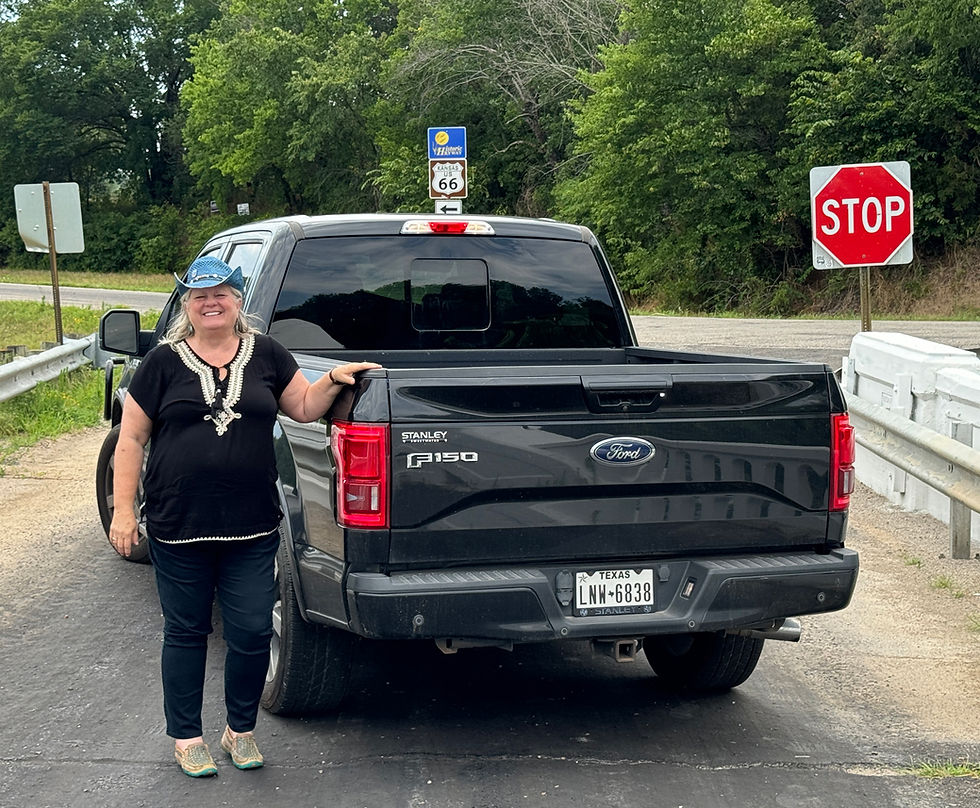Not in Kansas anymore? Think again
- Barbara Brannon
- Aug 16, 2024
- 4 min read
Updated: Sep 19, 2024
ROUTE 66 RAMBLE, PART 4 Of the eight states through which Route 66 once passed—and its historic remnants still do—Kansas claims the least, by far. But that 12.8-mile-long elbow jutting into the state’s southeasternmost corner has played an outsized role in the culture of the Mother Road, and in its survival for roadies to drive today.
In the second half of the twentieth century, progress in the form of one of the U.S.’s earliest high-speed Interstate highways—I-44, which extends now from St. Louis to Wichita Falls, Texas—replaced Route 66 along a wider and straighter path.
(Roadgeek trivia, per Wikipedia: As US 66 was being bypassed by I-44, the Route 66 Association requested the designation “Interstate 66” for I-44 from St. Louis to Oklahoma City; transportation officials rejected the request.)
Part of that straighter-path philosophy was to eliminate Route 66’s right-angle into Kansas entirely.
As we departed Missouri and crossed the yellow-brick stripe on old 66 that marks the state line into Kansas, we at first wondered why anyone might care. Then, around the bend, a delightful mishmash of Route 66 reminders hove into view.
A drive-through aluminum highway shield.

In the second half of the twentieth century, progress . . . replaced Route 66 along a wider and straighter path. Part of that straighter-path philosophy was to eliminate Route 66’s right-angle into Kansas entirely.
A pole design pointing to destinations as disparate as Amarillo (474 miles), Tucumcari (579), and Santa Monica Pier, CA (left blank, but it’ll take us another week to get there).
And spying from atop an iron post just as sneakily as he might’ve done behind a billboard in the 2006 “Cars” movie, a twin of the Sheriff’s 1949 black-and-white-with-cherry-on-top police cruiser.
We laughed when we also discovered a facsimile of Luigi the Fiat peeking out of a garage door.
Turns out we’d barely scratched the surface.
Back in 2001, Galena provided a pivotal bit of pop culture during Pixar director John Lasseter’s scouting expedition for an animated film he’d begun to envision during a cross-country family vacation the summer before.
There, outside a run-down Kan-O-Tex filling station, his team spotted a rusted, run-down vintage tow truck. And he met the truck’s owner, who possessed the redoubtable skill of bending his double-jointed legs in opposite directions.
Kay and I, knowing only a few tidbits of this history, cruised right on through Galena, most of whose establishments weren’t yet open for the day. Right up the road in Baxter Springs, Kansas’ Route 66 Visitor Center, was. The restored Phillips 66 station also offered public restrooms.
I swung open the door into the tiny lobby. Before either of us could inquire directions to the loo, the greeter bellowed out, “What’s your favorite character in ‘Cars’?”
“Um . . . Sally the Porsche?” I ventured.
“Wrong.”
I tried again, the correct answer dawning on me after taking in the memorabilia and photos that festooned the walls throughout the station.
“Mater!” I supplied, slapping my forehead.
Dean “Crazy-Legs” Walker proceeded to perform for us the famous stunt that had inspired the “Cars” team to give their friendly tow truck its memorable reverse-gear characteristic.
Walker’s only one of the legendary personalities who lent their true stories and knowledge to the movie — which in turn brought multiple generations of new fans to experience the real Route 66 for themselves. Here in Galena, once a run-down, rusted-out mining town bypassed by the big-muscle road, authenticity fed the inspiration for a pop-culture phenomenon that would eventually drive dollars back into tiny-town economies for 2,448 miles.
The three Kansas towns we visited multiple times that day — motoring back into Missouri and across to Oklahoma and back again to photograph the Route 66 zeitgeist in differing light—captured for us the evolution of a road from Roaring Twenties enthusiasm to Fifties heyday to crumbling ’80s ruin and back again.
We thrilled at the ability to drive across the one remaining segment of a Marsh Arch “rainbow” bridge across Brush Creek between Riverton and Baxter Springs, which launched us into fond memories of crossing a similar, larger, preserved bridge last summer in Fort Morgan, Colorado.
We gleaned even more appreciation for these sites from the streaming audio content we’d discovered at the outset of our journey, Anthony Arno’s “Route 66 Podcast.” Arno’s format includes bits of backstory, but the host mostly provides generous stretches of airtime for his interview guests to ramble at will. It’s an informative and inspiring way to learn about the children of the Mother Road.
We’d already listened to the wonderful opening segment with Michael Wallis, author of “Route 66: The Mother Road” (first published in 1990 and updated since then). It’s Wallis’s gravelly voice “Cars” fans will immediately recognize as that of the Sheriff and that millions of roadies recognize as belonging to one of the moving forces in saving the Route.
We finished our afternoon in Kansas learning from a few more of the road’s characters, warriors and champions. A lovely golden light settled over the old Kan-O-Tex Station, where a family snapped photos and waved good-bye to the real county sheriff, who’s married to the station’s co-owner and was making a few fix-ups (that’s a story for another day). We marveled at the ripple effect that’s brought Route 66 nostalgia to a whole new generation.
That’s a lot of value for just 12.8 miles.
READ MORE about the real-life inspirations for the Disney/Pixar “Cars” characters in a piece just out by Amarillo author Nick Gerlich in “Route” Magazine, www.routemagazine.us/stories/the-cars-story
PHOTO ALBUMS FOR THIS SEGMENT, KANSAS























Comments